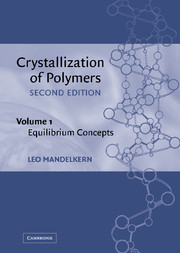Book contents
- Frontmatter
- Contents
- Preface to second edition
- Preface to first edition
- 1 Introduction
- 2 Fusion of homopolymers
- 3 Polymer–diluent mixtures
- 4 Polymer–polymer mixtures
- 5 Fusion of copolymers
- 6 Thermodynamic quantities
- 7 Fusion of cross-linked polymers
- 8 Oriented crystallization and contractility
- Author index
- Subject index
4 - Polymer–polymer mixtures
Published online by Cambridge University Press: 29 January 2010
- Frontmatter
- Contents
- Preface to second edition
- Preface to first edition
- 1 Introduction
- 2 Fusion of homopolymers
- 3 Polymer–diluent mixtures
- 4 Polymer–polymer mixtures
- 5 Fusion of copolymers
- 6 Thermodynamic quantities
- 7 Fusion of cross-linked polymers
- 8 Oriented crystallization and contractility
- Author index
- Subject index
Summary
Introduction
This chapter is concerned with the thermodynamic aspects of the fusion of binary mixtures of two homopolymers. The structural and morphological features that result from the departure from equilibrium, and their influence on properties, will be discussed in a subsequent chapter. Binary polymer blends present several different situations. An important distinction has to be made as to whether the components are miscible, immiscible or partially miscible with one another in the molten or liquid state. Flory has pointed out that the mixing of two polymeric components in the liquid state follows normal thermodynamic principles. Since the entropy change of mixing two long chain molecules is small, only a minute, positive enthalpic interaction will produce limited miscibility. It can then be expected that incompatibility of chemically dissimilar polymers should be the general rule. Experiment supports this conclusion. Compatibility, or miscibility, should be the exception. However, many polymer pairs have been found that are miscible, or partially miscible, with one another. Miscibility involves very specific, favorable interactions between the two components. Among the types of interactions involved are hydrogen bonding, charge transfer complexing and dipolar effects.
There are different situations within the miscible or partially miscible categories that need to be recognized and analyzed separately. The main groupings are: mixtures of two chemically different species, only one of which crystallizes; two chemically different species, each of which crystallizes independently; two chemically different species that co-crystallize; and mixtures of chemically identical polymer species that either do or do not co-crystallize.
Information
- Type
- Chapter
- Information
- Crystallization of Polymers , pp. 122 - 140Publisher: Cambridge University PressPrint publication year: 2002
